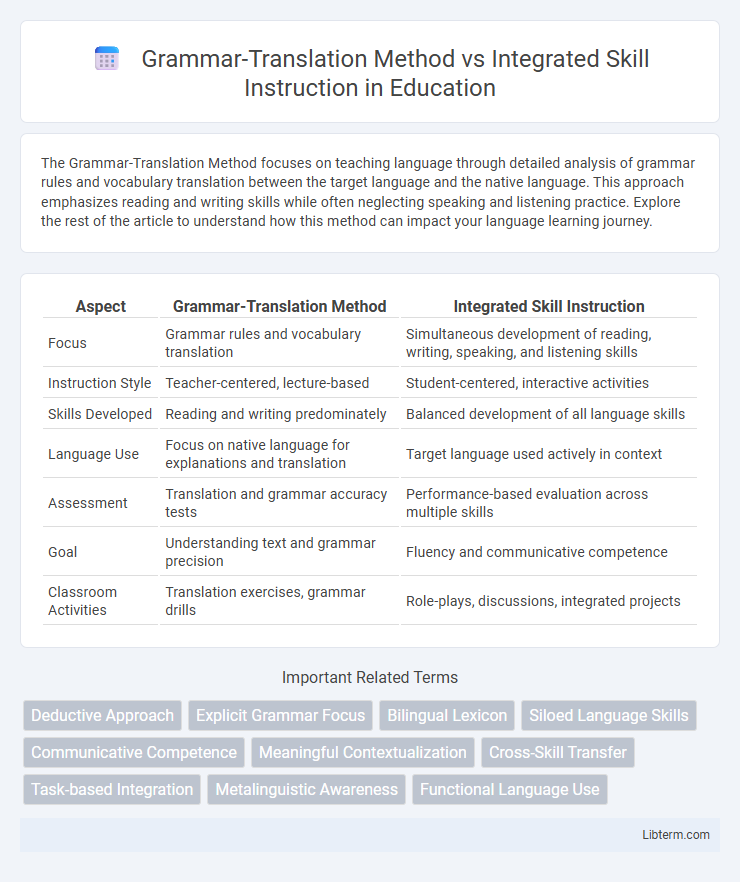The Grammar-Translation Method focuses on teaching language through detailed analysis of grammar rules and vocabulary translation between the target language and the native language. This approach emphasizes reading and writing skills while often neglecting speaking and listening practice. Explore the rest of the article to understand how this method can impact your language learning journey.
Table of Comparison
| Aspect | Grammar-Translation Method | Integrated Skill Instruction |
|---|---|---|
| Focus | Grammar rules and vocabulary translation | Simultaneous development of reading, writing, speaking, and listening skills |
| Instruction Style | Teacher-centered, lecture-based | Student-centered, interactive activities |
| Skills Developed | Reading and writing predominately | Balanced development of all language skills |
| Language Use | Focus on native language for explanations and translation | Target language used actively in context |
| Assessment | Translation and grammar accuracy tests | Performance-based evaluation across multiple skills |
| Goal | Understanding text and grammar precision | Fluency and communicative competence |
| Classroom Activities | Translation exercises, grammar drills | Role-plays, discussions, integrated projects |
Introduction to Grammar-Translation Method
The Grammar-Translation Method emphasizes explicit teaching of grammatical rules and vocabulary through direct translation between the target language and the native language. It prioritizes reading and writing skills, often neglecting speaking and listening, to develop strong grammatical accuracy and comprehension. This traditional approach contrasts with Integrated Skill Instruction, which blends listening, speaking, reading, and writing to enhance communication proficiency holistically.
Overview of Integrated Skill Instruction
Integrated Skill Instruction combines reading, writing, listening, and speaking into cohesive lessons that reflect real-life communication contexts. This approach emphasizes meaningful interaction and contextual understanding over isolated grammar drills, promoting language fluency and practical usage. Unlike the Grammar-Translation Method, which centers on memorization and accuracy, Integrated Skill Instruction fosters comprehensive language competence and learner engagement.
Historical Background of Both Methods
The Grammar-Translation Method emerged in the 19th century, rooted in classical language teaching and emphasizing the explicit learning of grammatical rules and vocabulary through translation exercises. Integrated Skill Instruction developed in the late 20th century as a response to traditional methods, promoting simultaneous development of listening, speaking, reading, and writing skills to mirror authentic language use. The historical shift from Grammar-Translation to Integrated Skill Instruction reflects broader pedagogical trends favoring communicative competence over rote memorization.
Core Principles of Grammar-Translation Method
The Grammar-Translation Method emphasizes the systematic teaching of grammatical rules, vocabulary memorization, and translation exercises between the target language and the native language to build reading and writing proficiency. This approach prioritizes accuracy, explicit understanding of grammar structures, and rote learning over communication skills and speaking fluency. It relies on classical texts and often neglects listening and speaking practice, focusing primarily on written language analysis and grammatical correctness.
Key Features of Integrated Skill Instruction
Integrated Skill Instruction emphasizes simultaneous development of listening, speaking, reading, and writing skills, promoting holistic language proficiency. It incorporates authentic materials and real-life contexts to enhance communication effectiveness and learner engagement. This method prioritizes interactive activities and meaningful practice, contrasting with the Grammar-Translation Method's focus on isolated grammar rules and translation exercises.
Comparing Teaching Strategies and Techniques
The Grammar-Translation Method emphasizes explicit teaching of grammar rules and vocabulary through direct translation and written exercises, prioritizing reading and writing skills over oral communication. Integrated Skill Instruction combines listening, speaking, reading, and writing activities to facilitate holistic language acquisition, encouraging real-life communication and contextual learning. While Grammar-Translation relies on memorization and accuracy, Integrated Skill Instruction promotes fluency and interactive skill development through diverse, learner-centered techniques.
Impact on Language Acquisition
The Grammar-Translation Method emphasizes rote memorization of grammar rules and vocabulary, which often results in limited communicative competence and slower language acquisition. In contrast, Integrated Skill Instruction promotes simultaneous development of listening, speaking, reading, and writing skills, enhancing practical language use and accelerating proficiency. Research shows that learners exposed to Integrated Skill Instruction demonstrate higher retention and improved fluency compared to those relying solely on Grammar-Translation approaches.
Advantages and Limitations of Each Approach
The Grammar-Translation Method emphasizes explicit understanding of grammar rules and vocabulary, promoting reading and writing proficiency but often neglecting speaking and listening skills. Integrated Skill Instruction fosters balanced development across speaking, listening, reading, and writing, enhancing communicative competence yet may lack focused grammar drills for accuracy. While the Grammar-Translation Method suits learners aiming for literary translation or academic purposes, Integrated Skill Instruction benefits everyday communication and real-life language use.
Situational Suitability: Which Method When?
The Grammar-Translation Method excels in formal academic settings where emphasis on reading comprehension and grammatical accuracy is required, making it ideal for learners focused on literary analysis or language certification exams. Integrated Skill Instruction suits communicative environments demanding simultaneous development of listening, speaking, reading, and writing skills, beneficial for real-world social interactions and professional contexts. Choosing between methods depends on learners' goals, with Grammar-Translation favored for analytical language tasks and Integrated Skill Instruction optimal for holistic language proficiency.
Future Trends in Language Teaching Methods
Future trends in language teaching methods emphasize a shift from the Grammar-Translation Method, which prioritizes rote memorization and grammatical accuracy, toward Integrated Skill Instruction that fosters holistic language development by combining speaking, listening, reading, and writing skills. Emerging approaches leverage technology-enhanced environments to support interactive and immersive learning experiences, promoting communicative competence over isolated linguistic forms. Adaptive learning platforms and data-driven feedback mechanisms are expected to further personalize instruction, aligning with the global demand for practical language use in diverse real-world contexts.
Grammar-Translation Method Infographic

 libterm.com
libterm.com